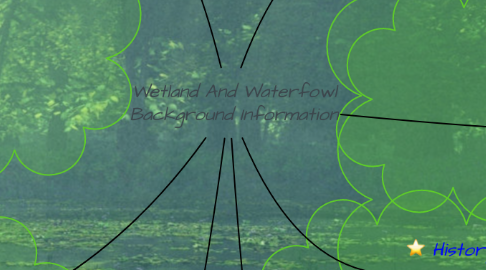
1. Major Wetland Types
1.1. Marshes
1.1.1. Marshes Depth Can Range From 1 Inch To Several Feet Deep Fluctuating From Year To Year. They Are Also Known As Flooded Grasslands.
1.2. Swamps
1.2.1. Swamps Are Known As Flooded Woodland Due The Large Amount Of Trees That Have Evolved To Survive And Flourish In These Type Of Conditions.
1.3. Bogs
1.3.1. A Bog Is When A Pond Or Lake Is Covered In A Layer Of Decaying Plant Matter. Bogs Are Highly Acidic And Only Toxic Tolerant Plant Can Be Found In These Waters And Same Goes For The Wildlife.
2. Why Wetlands Are Important.
2.1. They Help With Flooding Of Rivers Lakes And Water Basins.
2.2. They Clean And Or Clarify Water That Is Transferred Into Rivers And Helps With Pollution.
2.3. They Produce Large Amounts Of Oxygen Due To Their Immense Amount of Plant Life Density.
3. Waterfowls Annual Cycles And Seasonal Needs.
3.1. Waterfowls Or Ducks Spend Most Of Their Time In The Winter Trying To Find A Mate And Raise Their young.
3.2. In The Spring Waterfowls Spend Most Their Time Migrating, Breeding, Nesting, And Rear Their Brood.
3.3. During The The Hot Summer Months Waterfowls Mainly Feed On High-Energy Food To Gain Lots of Protein Before Molting Which Consumes Lot Of Protein.
3.4. Waterfowls Travel All Over And Their Diet Changes Depending On The Time Of Year It Is So If You Are To Ever See A Waterfowl Educate Yourself About What Times Of Years They Eat What When.
4. Waterfowls
4.1. Wood Ducks.
4.1.1. The Wood Duck Also Known As The Carolina Duck Is One Of The Most Colorful Waterfowls.
4.2. Blue-Winged Teal
4.2.1. The Blue Winged Teal Is One Of Smallest Duck Species. It Also Migrates From Texas To Alaska.
4.3. Mallards
4.3.1. Mallard Ducks Have The Most Extensive Breeding Range Of Any North American Ducks.

